The Perception That A Stationary Object Is Moving Is Called
Kalali
Jun 14, 2025 · 3 min read

Table of Contents
The Perception that a Stationary Object is Moving is Called: An Exploration of Illusory Motion
Have you ever been sitting in a train at a station, only to glance out the window and feel like the train next to you is moving, even though it's actually your own train that's starting to roll? This common experience highlights a fascinating aspect of human perception: the sensation that a stationary object is moving. This phenomenon, often subtle yet surprisingly powerful, has been extensively studied in the field of visual perception and is known as illusory motion, or more specifically, induced motion.
This article delves into the various types of illusory motion, exploring the neurological mechanisms behind them and their implications for our understanding of visual processing. We'll also examine how these illusions can manifest in everyday life and how they relate to other perceptual phenomena.
Understanding Illusory Motion: More Than Just a Trick of the Eye
Illusory motion isn't simply a "trick of the eye" but a complex interaction between various visual and neurological processes. The brain actively constructs our perception of the world, and sometimes this construction leads to inaccurate interpretations of sensory input. In the case of induced motion, the movement of one object is incorrectly attributed to a stationary object. This often occurs when the stationary object is positioned near a moving object, particularly against a contrasting background. The brain struggles to accurately segregate the objects and misinterprets the relative movement.
Types of Illusory Motion: A Diverse Range of Experiences
While induced motion is a prominent example, several other types of illusory motion exist. These include:
- Autokinetic effect: A stationary point of light in a completely dark room will appear to move, likely due to subtle eye movements and the brain's attempt to interpret ambiguous visual information.
- Motion aftereffect: After prolonged exposure to movement in a particular direction (e.g., watching a waterfall), stationary objects might appear to move in the opposite direction. This is attributed to the adaptation of motion-sensitive neurons in the visual cortex.
- Phi phenomenon: This refers to the illusion of movement created by presenting two stationary stimuli in rapid succession. Classic examples include flickering lights that seem to move smoothly, a technique used in early animation.
- Stroboscopic motion: Similar to the phi phenomenon, this involves presenting a series of still images in rapid succession, creating the illusion of continuous movement. This is the fundamental principle behind movies and animation.
Neurological Basis of Illusory Motion: A Complex Dance of Neurons
The neurological underpinnings of illusory motion are complex and still not fully understood. However, research suggests a significant role played by the middle temporal (MT) area of the brain, a region heavily involved in motion processing. The MT area receives input from the retina and processes information about direction and speed of movement. When presented with ambiguous visual stimuli, the MT area can produce erroneous signals, leading to the perception of motion where none exists.
Implications and Applications: Beyond a Simple Illusion
The study of illusory motion is not merely an academic exercise. Understanding these perceptual phenomena has significant implications for various fields:
- Driving safety: Induced motion can contribute to errors in judgment while driving, especially in low-visibility conditions.
- Design and user interface: Understanding motion perception is crucial in designing intuitive and effective user interfaces.
- Virtual reality and augmented reality: Creating realistic and immersive virtual experiences requires a thorough understanding of how our brains perceive motion.
Conclusion: The Ever-Enigmatic World of Perception
Illusory motion, in its various forms, serves as a powerful reminder of the brain's active role in constructing our perception of reality. While these illusions might sometimes be misleading, they provide invaluable insights into the complexities of visual processing and the remarkable yet sometimes imperfect mechanisms of our sensory systems. Future research continues to unravel the intricate neurological basis of these fascinating perceptual phenomena.
Latest Posts
Latest Posts
-
The Vulva Includes All Of The Following Except The
Jun 15, 2025
-
Lcm Of 3 6 And 7
Jun 15, 2025
-
Area Of Nepal In Sq Km
Jun 15, 2025
-
Who Is Considered The Father Of Modern Psychology
Jun 15, 2025
-
Excel Is An Example Of What Type Of Software
Jun 15, 2025
Related Post
Thank you for visiting our website which covers about The Perception That A Stationary Object Is Moving Is Called . We hope the information provided has been useful to you. Feel free to contact us if you have any questions or need further assistance. See you next time and don't miss to bookmark.